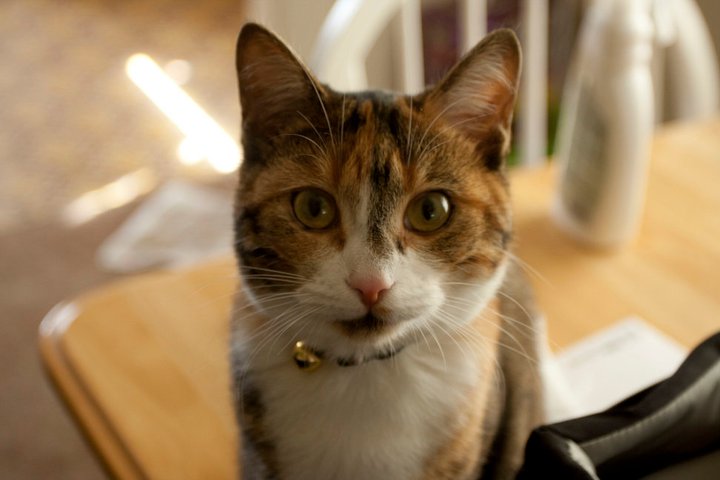By Chelsy Ranard
When I adopted my cat, Kitten (original name, I know), I was a broke, 19-year-old college student. One day  I was driving home from work and I saw a sign on the road that said, “Free Kittens,” and for some reason I decided to turn in. I figured I had a part-time job and I had the means to care for a new, furry companion. When I parked my car and got out, I was greeted by two little girls around the age of nine. They took me to the side of their barn and up to a barrel and they pointed inside. I looked in and three sets of tiny eyes stared up at me. Three 10-week-old kittens were cuddled together and purring. After playing with all three of them, picking them up and petting them and asking the little girls about their personalities, I picked the calico female. According to the girls, she was, “crazy and hyper,” and always tried to wrestle her brother and sister. I was in love. She tried to attack my hair and climb on top of my head. I thanked the girls and took my new kitten home.
I was driving home from work and I saw a sign on the road that said, “Free Kittens,” and for some reason I decided to turn in. I figured I had a part-time job and I had the means to care for a new, furry companion. When I parked my car and got out, I was greeted by two little girls around the age of nine. They took me to the side of their barn and up to a barrel and they pointed inside. I looked in and three sets of tiny eyes stared up at me. Three 10-week-old kittens were cuddled together and purring. After playing with all three of them, picking them up and petting them and asking the little girls about their personalities, I picked the calico female. According to the girls, she was, “crazy and hyper,” and always tried to wrestle her brother and sister. I was in love. She tried to attack my hair and climb on top of my head. I thanked the girls and took my new kitten home.
Here are some tips I learned by adopting a cat without understanding the real costs of owning a cat and starting the life of a thrifty cat owner. According to the ASPCA, on average, a cat costs just over $1,000 per year to care for properly. That does not include emergency situations that can often cost thousands more. There are things you can do if you find yourself in a tough position, but I wouldn’t recommend adopting an animal without being able to afford it.
Thrifty Tip #1: Do it yourself (DIY)
DIY saved a very boring life for Kitten. When I brought her home, I made her a no-sew pet bed that only requires some fleece and stuffing. I made her a cat tent out of an old shirt and some hangers, I made her toys out of shoe laces and craft supplies I had laying around. My dad built her a cat tree using scrap materials. All of these projects were super easy, cheap, and Kitten loved them. Before venturing into the DIY world, be sure to check the quality of your materials! Yarn, for instance, can be dangerous for cats and cause intestinal blockage if swallowed.
Thrifty Tip #2: Find Deals
If you’re trying to be frugal, I don’t recommend using big chain stores to buy your pet supplies. However, for the necessities you can’t help but purchase new, there is always a deal available. You just have to find it. There are a ton of sites that offer coupons for big outlets. Some pet stores offer pet rewards cards, stamp cards, and coupons with certain purchases. A small discount goes a long way if you are consistent.
Thrifty Tip #2: Thrift Shop
Before you go finding coupons, make sure you try the thrift shop. I’ve purchased cat boxes, food dishes, and toys for Kitten at thrift stores. And not everything is used, some things are brand new. The downside is that while it saves you money, it doesn’t necessarily save you time to go the thrift store route. There is a lot of searching involved, but it is definitely the cheaper option. Again, be sure to find high quality items for your cat. Safety is priority one!
Thrifty Tip #4: Seek Low-Cost Pet Programs
Keep an eye out for low cost pet programs in your area. I was able to get Kitten spayed for free through a free spay/neuter program offered by the Humane Society in the town I lived in. These programs usually aren’t offered all year, so be sure to do your research. There are also programs for low-income families to get your cat its shots, flea/tick treatments, and grooming. Try to donate to these groups if you can, they are mostly non-profits so they would appreciate a contribution of some kind although they usually don’t require it.
Thrifty Tip #5: Bake Your Own Cat Treats
Making your own cat treats is so easy and will save you money. Granted, cat treats aren’t the most expensive purchase for your cat, but most of the ingredients necessary to make the treats are things you will probably already have in your cupboards and you can make a ton at once. The treats I make for Kitten requires tuna, flour, an egg, vegetable oil, and cornmeal. Be knowledgeable on certain ingredients that will harm your cat when baking. Milk, for instance, is not good for your cat, so do your research!
Whether I’m creating a kitty DIY project or baking some healthy cat treats, I’m still practicing my frugal tips. I’m considerably better off financially now than I was when I started my thrifty lifestyle, but I still practice these tips that I learned back when Kitten was a kitten. As a college student I so rarely made informed decisions, and adopting an animal without doing my homework was just one of the many. For more information on pet care costs, visit the ASPCA website to learn more.
 Author Bio: Chelsy is a writer from Montana who is now living in Boise, Idaho. She graduated with her journalism degree from the University of Montana in 2012. When she isn’t spending time with her beloved Kitten, she enjoys playing Frisbee, camping, and drinking fruity wine. She volunteers at Simply Cats and is passionate about animal welfare.
Author Bio: Chelsy is a writer from Montana who is now living in Boise, Idaho. She graduated with her journalism degree from the University of Montana in 2012. When she isn’t spending time with her beloved Kitten, she enjoys playing Frisbee, camping, and drinking fruity wine. She volunteers at Simply Cats and is passionate about animal welfare.
Twitter: @Chelsy5 | Facebook: Chelsy Ranard
